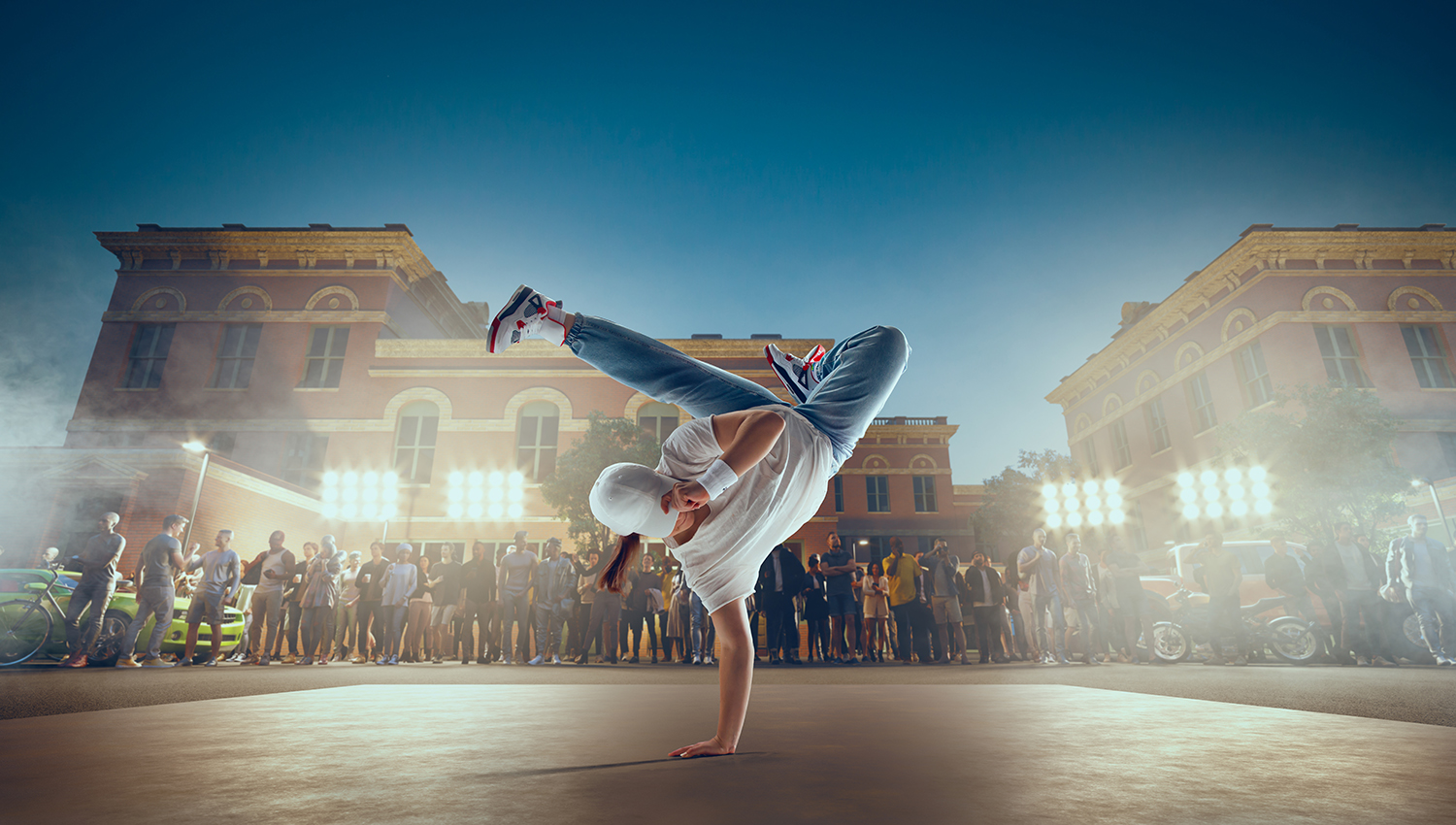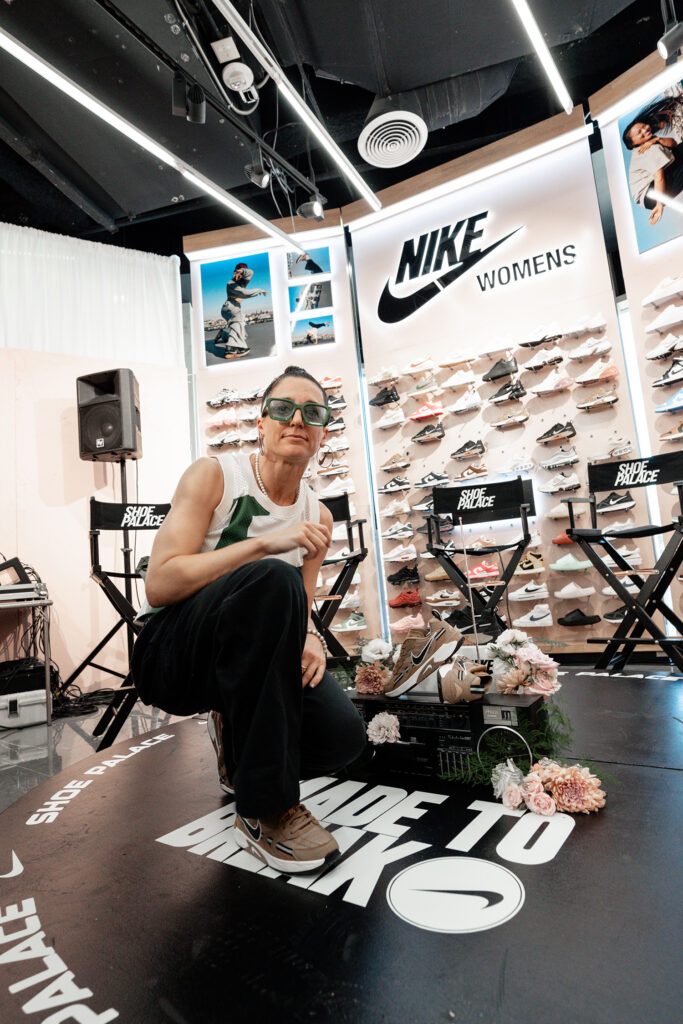09.04.2024
By uscbknpt
Capturing the Moment

Understanding the art and sports science of breaking (also known as breakdancing) in a new multidisciplinary collaboration at USC.
BY MICHELLE McCARTHY
WHEN YOU THINK OF OLYMPIC EVENTS, chances are you don’t envision athletes in baggy clothing spinning on their heads. But that’s exactly what viewers witnessed when breaking (not “breakdancing”) made its debut at the 2024 Games in July.
While the dance originated in the 1980s, its newly attained status as an Olympic event has provided a heightened profile. Nike even released its first-ever breaking shoe, and it was engineered specifically for B-girls (female breakers).
For B-girl Randi Freitas, who was introduced to the artform at a Roots concert years ago, the news was monumental. “It’s huge that they created a breaking shoe, and even bigger that they focused on women in the process!” she says. “It’s never been done. Usually, the testing is done on men and then they ‘shrink it and pink it’ for women, which results in the loss of some valuable technology.”
Multidisciplinary collaboration is key
With all of this newfound attention on the sport, Susan Sigward PhD ’04, associate professor of clinical physical therapy and director of the master’s in biokinesiology program, saw a perfect opportunity for a multidisciplinary collaboration across USC involving the USC Division of Biokinesiology and Physical Therapy, the Jimmy Iovine and Andre Young Academy (IYA) and the USC Glorya Kaufman School of Dance.
“The goal is to create this intersection of all of the amazing research and medical advances that we’re spearheading on the health sciences campus and intertwine them with creative and innovative practices,” says Malcolm Jones MS ’19, PhD ’23, director of health innovation at IYA.
“Motion capture technologies are tools that are common in sports science and creative design, animation and cinema” Sigward says. “IYA’s motion capture studio traditionally focuses on more creative design and arts projects while biokinesiology and sports science use very similar technologies to assess optimal and less efficient movement.”

With its new minor in health innovation, IYA saw a perfect opportunity to team up with the sports science program to further stimulate undergrad students’ interest in the technology.
“I thought breaking would be a perfect project because of the challenge of applying these technologies to a sport that blends a high level of creativity with physically demanding skills,” Sigward says. “The Olympics were coming up, and the project seemed to be a good way to also collaborate with the Kaufman School of Dance.”
Enter master of science biokinesiology student Katie Kim MS ’25, who was hired to serve as an intermediary among the three divisions.
“For the IYA students, this is not only introducing them to the world of sports science and motion capture, but it’s forcing them to come up with solutions to a question that really hasn’t been answered by anyone,” Kim explains. “We have all these metrics for other sports, but we don’t have anything like that for breaking.”
Preventing injuries and heightening performance
Traditional motion capture works by affixing sensors to dancers (in this case, Freitas and Danté Rose, a lecturer at the USC Kaufman School of Dance) and tracking their movements, which is then translated into data that can be analyzed. However, these sensors can interfere with the more complex breaking moves.
The initial objective of the project is twofold — to determine how to collect breaking movement data and then translate standardized biomechanic metrics for breaking into actionable insights to help prevent injuries and heighten performance.
Due in part to performing on concrete floors and public streets, breakers are the most injured types of dancers — a reality with which Freitas is all too familiar. “I have had multiple injuries: a vertebra out of place causing nerve issues in my left arm, a pulled groin, multiple sprained thumbs, a broken big toe, issues with my left knee, issues with both rotator cuffs and muscular locking of my neck,” she says.
“With breaking, we have to look at the head and the neck because the dancers are upside down,” Kim shares. “We have to look at their wrists because they do handstands, and they’re throwing themselves in the air and whipping their legs around. We have to look at their knees and their hips — so it’s all over the place.”
As a result of her exposure to biomechanics, Freitas says her recovery time has vastly improved. “I better understand the impact on my body and the demands of breaking, so I pay more attention to cross training outside of breaking, focusing on the mobility and strength needed, as well as the recovery necessary to make sure I am at peak performance. The motion capture showed me that, as I got more fatigued throughout the day, my hips would sit lower in my swipes [a basic power move].”
Building a stronger team
While this project is still in its infancy, Kim has plans to widen its scope. “This fall, we’re hoping to incorporate students from the IYA with their challenge-based learning model and Kaufman students who enroll in the breaking class. My goal is to get the dancers in at the beginning of the semester, do a data recording session to see what their baseline is, have them go through the entire class, and then bring them in again at the end of the semester. Eventually, we want to work with sports science and physical therapy students as well.”
Since this partnership has so many different components involved, Sigward says the possibilities for collaboration are endless and that it will better prepare USC students for life after graduation.
“Sport science is not a single person. It is a blend of their expertise across a bunch of different disciplines: medical, coaching, strength and conditioning, physiology, biomechanics, engineering and data analysis,” Sigward says. “A sport scientist learns to work within this team to achieve a goal of optimizing performance. This model of working together as a team of people with different strengths is also at the heart of the IYA learning experience making this collaboration across schools a great model for preparing students for this emerging field.”

